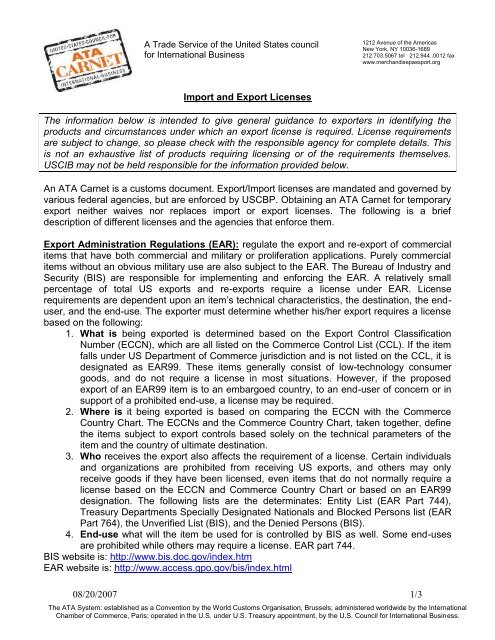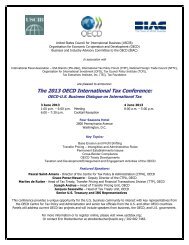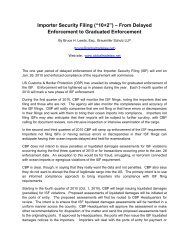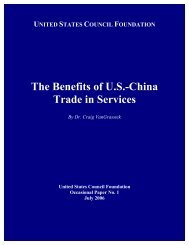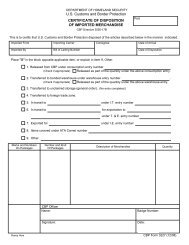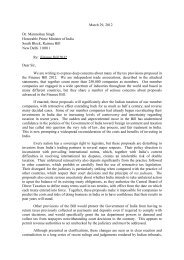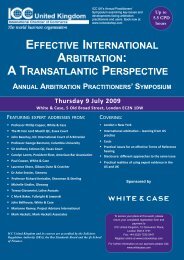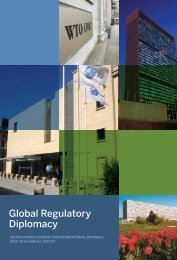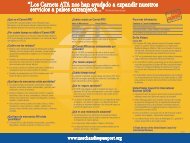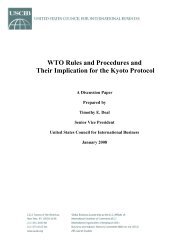Import and Export Licenses - U.S. Council for International Business
Import and Export Licenses - U.S. Council for International Business
Import and Export Licenses - U.S. Council for International Business
Create successful ePaper yourself
Turn your PDF publications into a flip-book with our unique Google optimized e-Paper software.
A Trade Service of the United States council<br />
<strong>for</strong> <strong>International</strong> <strong>Business</strong><br />
1212 Avenue of the Americas<br />
New York, NY 10036-1689<br />
212.703.5067 tel 212.944..0012 fax<br />
www.merch<strong>and</strong>isepassport.org<br />
<strong>Import</strong> <strong>and</strong> <strong>Export</strong> <strong>Licenses</strong><br />
The in<strong>for</strong>mation below is intended to give general guidance to exporters in identifying the<br />
products <strong>and</strong> circumstances under which an export license is required. License requirements<br />
are subject to change, so please check with the responsible agency <strong>for</strong> complete details. This<br />
is not an exhaustive list of products requiring licensing or of the requirements themselves.<br />
USCIB may not be held responsible <strong>for</strong> the in<strong>for</strong>mation provided below.<br />
An ATA Carnet is a customs document. <strong>Export</strong>/<strong>Import</strong> licenses are m<strong>and</strong>ated <strong>and</strong> governed by<br />
various federal agencies, but are en<strong>for</strong>ced by USCBP. Obtaining an ATA Carnet <strong>for</strong> temporary<br />
export neither waives nor replaces import or export licenses. The following is a brief<br />
description of different licenses <strong>and</strong> the agencies that en<strong>for</strong>ce them.<br />
<strong>Export</strong> Administration Regulations (EAR): regulate the export <strong>and</strong> re-export of commercial<br />
items that have both commercial <strong>and</strong> military or proliferation applications. Purely commercial<br />
items without an obvious military use are also subject to the EAR. The Bureau of Industry <strong>and</strong><br />
Security (BIS) are responsible <strong>for</strong> implementing <strong>and</strong> en<strong>for</strong>cing the EAR. A relatively small<br />
percentage of total US exports <strong>and</strong> re-exports require a license under EAR. License<br />
requirements are dependent upon an item’s technical characteristics, the destination, the enduser,<br />
<strong>and</strong> the end-use. The exporter must determine whether his/her export requires a license<br />
based on the following:<br />
1. What is being exported is determined based on the <strong>Export</strong> Control Classification<br />
Number (ECCN), which are all listed on the Commerce Control List (CCL). If the item<br />
falls under US Department of Commerce jurisdiction <strong>and</strong> is not listed on the CCL, it is<br />
designated as EAR99. These items generally consist of low-technology consumer<br />
goods, <strong>and</strong> do not require a license in most situations. However, if the proposed<br />
export of an EAR99 item is to an embargoed country, to an end-user of concern or in<br />
support of a prohibited end-use, a license may be required.<br />
2. Where is it being exported is based on comparing the ECCN with the Commerce<br />
Country Chart. The ECCNs <strong>and</strong> the Commerce Country Chart, taken together, define<br />
the items subject to export controls based solely on the technical parameters of the<br />
item <strong>and</strong> the country of ultimate destination.<br />
3. Who receives the export also affects the requirement of a license. Certain individuals<br />
<strong>and</strong> organizations are prohibited from receiving US exports, <strong>and</strong> others may only<br />
receive goods if they have been licensed, even items that do not normally require a<br />
license based on the ECCN <strong>and</strong> Commerce Country Chart or based on an EAR99<br />
designation. The following lists are the determinates: Entity List (EAR Part 744),<br />
Treasury Departments Specially Designated Nationals <strong>and</strong> Blocked Persons list (EAR<br />
Part 764), the Unverified List (BIS), <strong>and</strong> the Denied Persons (BIS).<br />
4. End-use what will the item be used <strong>for</strong> is controlled by BIS as well. Some end-uses<br />
are prohibited while others may require a license. EAR part 744.<br />
BIS website is: http://www.bis.doc.gov/index.htm<br />
EAR website is: http://www.access.gpo.gov/bis/index.html<br />
08/20/2007 1/3<br />
The ATA System: established as a Convention by the World Customs Organisation, Brussels; administered worldwide by the <strong>International</strong><br />
Chamber of Commerce, Paris; operated in the U.S. under U.S. Treasury appointment, by the U.S. <strong>Council</strong> <strong>for</strong> <strong>International</strong> <strong>Business</strong>.
Endangered Species: The Convention on <strong>International</strong> Trade in Endangered Species of Wild<br />
Fauna <strong>and</strong> Flora (CITES) is an international agreement between governments that covers<br />
endangered species <strong>and</strong> potentially threatened species. Its aim is to ensure that international<br />
trade in specimens of wild animals <strong>and</strong> plants does not threaten their survival. CITES covers<br />
items with fur, seashells, elephant hair, <strong>and</strong> certain endangered leathers, to name a few. This<br />
link has the listed species http://www.fws.gov/permits/specieslists/specieslists.shtml. The US<br />
Fish <strong>and</strong> Wildlife Service’s <strong>International</strong> Management Authority is responsible <strong>for</strong> administering<br />
CITES <strong>for</strong> the United States www.fws.gov/le. Most persons who import <strong>and</strong> export wildlife must<br />
file a special declaration <strong>and</strong> may be required to have certain documents from <strong>for</strong>eign<br />
governments as well. In most cases, anyone importing or exporting wildlife or wildlife products<br />
must file a US Fish <strong>and</strong> Wildlife Service <strong>for</strong>m 3-177, which is the Declaration <strong>for</strong> <strong>Import</strong>ation or<br />
<strong>Export</strong>ation of Fish <strong>and</strong> Wildlife.<br />
Live Animals <strong>and</strong> Plants: US Department of Agriculture Animal <strong>and</strong> Plant Health Service<br />
regulate the export <strong>and</strong> import of live animals, <strong>and</strong> animal products. The export requirement<br />
that needs to be met prior to export is providing proof that the importing country’s regulations<br />
have been satisfied. The USDA Animal <strong>and</strong> Plant Health Inspection Service (APHIS),<br />
Veterinary Services (VS) has created the <strong>International</strong> Animal Product <strong>Export</strong> Regulations<br />
(IREGS) to provide exporters with the best underst<strong>and</strong>ing of importing countries requirements<br />
<strong>for</strong> certain animal-origin products. The requirements <strong>for</strong> re-importing of live animals into the US<br />
are based on the countries visited, <strong>and</strong> the length of stay in each country. This in<strong>for</strong>mation can<br />
be found on USDA’s website http://www.aphis.usda.gov/import_export/<br />
Arms: <strong>International</strong> Traffic in Arms Regulation (ITAR) controls the export <strong>and</strong> import of<br />
defense-related articles <strong>and</strong> services on the United States Munitions List.<br />
(http://www.access.gpo.gov/nara/cfr/waisidx_99/22cfr121_99.html). ITAR implements the<br />
provisions of the Arms <strong>Export</strong> Control Act, which is interpreted <strong>and</strong> en<strong>for</strong>ced by the<br />
Department of State’s Directorate of Defense Trade Controls (DDTC). Its goal is to advance<br />
national strategic objectives <strong>and</strong> US <strong>for</strong>eign policy via trade controls. For practical purposes,<br />
ITAR regulations dictate that in<strong>for</strong>mation <strong>and</strong> material pertaining to defense <strong>and</strong> military related<br />
technologies may only be shared with US persons unless approval from the Department of<br />
State is received or a special exemption is used. These protected items range from military<br />
defense weapons to designs, test data, processes, software code <strong>and</strong> commercial satellites.<br />
Any person who engages in the US in the business of either manufacturing or exporting<br />
defense articles, defense services or related technical data is required to register with DDTC.<br />
Registration does not confer any export rights or privileges, but it is a precondition to the<br />
issuance of any license or other approval <strong>for</strong> export. To register or renew a registration<br />
complete a <strong>for</strong>m DS-2032. The DDTC may issue a license <strong>for</strong> the temporary export of<br />
unclassified defense articles. Such licenses are valid only if:<br />
i. The article will be exported <strong>for</strong> a period less than four years <strong>and</strong> will be returned to<br />
the US.<br />
ii. Transfer of title will not occur during the period of temporary export<br />
To apply <strong>for</strong> the temporary export license the exporter will need to complete an application with<br />
the DDTC, (DSP-73). An original import authorization comprised of either an original permit or<br />
an original certificate issued by the <strong>for</strong>eign government authorizing the import of specified<br />
items, must accompany each application. This is not to be confused with a business license<br />
issued by the <strong>for</strong>eign government to firearms dealers or with a government authorization <strong>for</strong><br />
08/20/2007 2/3
individuals to own or carry a firearm. The ITAR provides <strong>for</strong> certain exemptions relative to the<br />
licensing of firearms <strong>and</strong> ammunition:<br />
i. Obsolete firearms <strong>and</strong> models: non-automatic firearms that were manufactured in or<br />
be<strong>for</strong>e 1898, as well as replicas of such firearms<br />
ii. Temporary export of firearms <strong>and</strong> ammunition <strong>for</strong> personal use: US persons may<br />
export temporarily not more than three non-automatic firearms <strong>and</strong> not more than<br />
1,000 cartridges of ammunition provided that this is <strong>for</strong> the person’s exclusive use <strong>and</strong><br />
not <strong>for</strong> re-export or other transfer of ownership<br />
iii. Minor components: components <strong>and</strong> parts <strong>for</strong> Category I firearms are exempt from<br />
licensing requirements when the total value does not exceed $100 wholesale in any<br />
single transaction. Barrels, cylinders, receivers (frame), or complete breech<br />
mechanisms require a license<br />
iv. Firearms <strong>for</strong> personal use <strong>for</strong> members of the US armed <strong>for</strong>ces <strong>and</strong> civilian employees<br />
of the US government: non-automatic weapons may be exported <strong>for</strong> personal use <strong>and</strong><br />
not <strong>for</strong> resale or transfer of ownership if the firearms are accompanied by written<br />
authorization from the comm<strong>and</strong>ing officer or Chief of the US Diplomatic Mission<br />
v. Canadian <strong>and</strong> Mexico border shipments: a shipment originating in Canada or Mexico<br />
that incidentally transits the US en route to a delivery point in that same country is<br />
exempt from the requirement <strong>for</strong> an in-transit license<br />
Nuclear Materials: Nuclear Regulatory Commission is the US licensing authority <strong>for</strong> exports<br />
<strong>and</strong> imports of nuclear materials <strong>and</strong> equipment. The commodities under NRC export licensing<br />
authority can be found at the following website: http://www.nrc.gov/about-nrc/ip/exportimport.html<br />
The NRC import/export licenses are granted depending on what is being exported,<br />
quantity <strong>and</strong> destination.<br />
Diamonds: Kimberly Process Certificate: US Census bureau requires faxed copies of this<br />
certificate upon export. This certificate can be found at www.kimberleyprocess.com. For<br />
exports of rough diamonds it is imperative to include the country of destination along with the<br />
importer’s name. For more in<strong>for</strong>mation on the process <strong>and</strong> other jewelry related requirements<br />
go to Jewelers Vigilance Committee.<br />
08/20/2007 3/3


